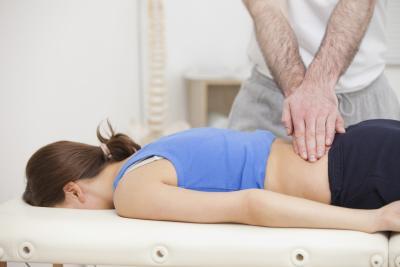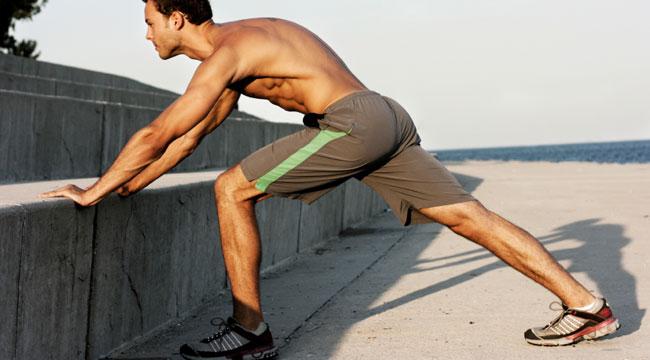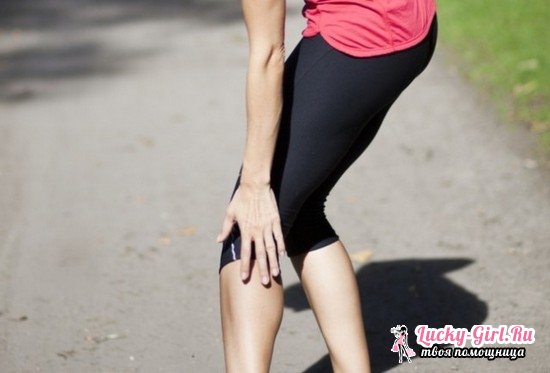First day after training. When does muscle pain require medical attention? If the pain occurs the day after training
Finally, you decided to take the righteous path and go in for sports. But the first difficulty has arisen for you - after the first lesson, your whole body hurts terribly, and you practically cannot move... Do you really have to stop training and wait for the soreness to completely disappear?
Muscles hurt after the first workout: why and what to do?
You trained conscientiously on the wings of enthusiasm and felt a surge of energy throughout the entire session. But bad luck - the next day every cell of the body, every muscle hurts. Why did this happen and what to do in such cases?
In practice we advise you. Wait 48 to 72 hours before working the same muscle group, look longer if you are working for failure, and use intensification techniques that prolong the recovery period. Take a day off after two days of consecutive training, 8 hours of sleep at night is the minimum, sleep more according to your needs. For example, it should be an excess amount of calories in the case of weight gain to increase muscle mass. Have a good diet tailored to your needs and goals. . So feel free to insert an extra day of rest between two workouts and a few weeks off after a few months without a break.
There is nothing strange in the fact that a beginner has pain all over his body; this is a completely normal phenomenon. It would be strange if you didn't feel pain. This would mean that you were not giving 100% in training. The problem is that many people immediately lose the desire to exercise after severe soreness. We hope you don't give up and keep going to the gym.
I asked myself the following question: why did we “break down” after playing sports, especially the next day? - asks Nicolas Baudry-Riendo. An explanation that has been heard often and for a long time, is that aches and pains are due to the accumulation of lactic acid in the muscles. A priori, this seems like a common sense assumption: we usually burn glucose to obtain the energy we need; This combustion, which mainly consists of the recombination of sugars with oxygen, generates two waste products, water vapor and carbon dioxide, but when we must provide intense and sustained effort, the bloodstream does not always have time to get as much oxygen to the muscles as they need.
Why do my muscles hurt after the first workout? Why does this happen and can it be prevented? The thing is that muscle tissue contains a substance called lactic acid. And after active sports, it begins to be actively eliminated, which is why unpleasant sensations appear in the muscles. Also, microtraumas form in muscle tissue under heavy loads; they are not dangerous. Because of these microtraumas, the pain becomes even stronger.
It is then physically impossible to burn enough sugar to produce all the energy needed, but our muscle cells must still find a way to compensate or they will stop contracting - to "paralyze" if you will. By doing this, each glucose molecule provides much less energy - 18 times less to be exact, although chemical reactions participate 2.5 times faster - but when oxygen is scarce, our cells have little other choice. And this fermentation, taking several steps, produces a large amount of waste, lactic acid, which is most often blamed for causing pain.
 Don’t worry, after a couple of days the pain will begin to go away, as the muscle tissue is quickly restored. If the pain does not disappear even after 4-5 days, consult a doctor - you may have suffered a sprain or other injury.
Don’t worry, after a couple of days the pain will begin to go away, as the muscle tissue is quickly restored. If the pain does not disappear even after 4-5 days, consult a doctor - you may have suffered a sprain or other injury.
Even professional athletes who have been involved in sports for many years often experience pain after intense training. Therefore, we recommend that you do not panic and wait a few days.
But if this, of course, is not very good idea In order to accumulate this acid in your muscles, it is still time to relax for the accused whose alibi cannot be stopped. Lactic acid is removed and carried into the blood like all other cellular waste, and studies have shown that it disappears in about an hour. The suspect left the crime scene for a long time when pain occurs, 24-48 hours after trying to sign that this cannot be the cause.
Moreover, the defense adds, these are mostly untrained people suffering from body pain; for example, the average runner is unlikely to feel it after a normal course, although perhaps after the first races. Although regular exercise improves cardiovascular system and the blood's ability to carry oxygen, this is not enough to cancel the resort of lactic fermentation cells. Therefore, lactic acid can be present without any curvature.
What to do if your muscles hurt after your first workout? If the sore throat has already appeared, you will not be able to get rid of it completely, but it is quite possible to reduce it. We will also give you advice for the future - try to add load gradually, do not overdo it.
You will like our publication How to get rid of sore throat?
Since this poor acid was sent out of prison with an apology from the authorities, suspicions of science turned into another bandit, muscle damage. It is quite possible that aches and pains are nothing more than this: without going so far as to talk about the tearing of some of the microfibers that make up our muscles, what remains is that intense effort and for which we are ill-prepared to damage often parts of the muscles, especially protein assemblies called sarcomeres essentially stretch them, as we saw under the microscope, which has the advantage of explaining why "inflatable muscles" only harm us when they are infected or palpable, and not when they are left dormant.
To prevent severe soreness, be sure to do a 10-minute warm-up before class, and after it, do several stretching exercises.
Ways to eliminate pain after the first workout:

As we have already said, the sore throat is unlikely to disappear completely. You'll have to wait a few days; time is the best healer in this case.
But as physics researcher Ken Nosaka of Edith-Cowan University in Australia writes in the chapter "Skeletal Muscle Damage and Repair," this suspect also has the same alibi as lactic acid. Muscle damage is measured by loss of strength, swelling or other indicators, and the amount of damage is not affected by aches and pains. Additionally, he notes that remobilizing muscle pain 24 or 48 hours after the first exercise does not worsen the damage, but instead eliminates the pain - more sore after 5-10 minutes, which seems to contradict the idea that pain will protect wrinkled muscles .
Probably every person at least once in his life has experienced some unexpected physical activity that resulted in muscle pain for several days. Or, on the contrary, you decided to start new life, where the leading role is given to the gym. Why do my muscles hurt after training?
Why do muscles hurt after training?
Muscle pain caused by physical exercise, may differ. Insufficient warm-up before starting exercise may result in injury. And with the proper approach and control from the trainer, muscle pain can be interpreted as positive.
Preparation for training begins long before the warm-up begins. gym. And like everything else in life, poor preparation leads to... bad work. this can be expressed as incomplete training or injury - things that prevent you from achieving your goals. That's why we offer you some preparation tips before loading into the gym.
No matter what you think is good to eat, pay attention to what you eat. The amount of carbohydrates and protein should match your goals. Peanut butter toast is good option, because it contains carbohydrates, fats and proteins. Fruits such as bananas, apples and oranges are rich in carbohydrates, which you will need to fuel your workout. Squirrels tremble or also work.
Finding out the causes of muscle pain after the first workout
In the muscle loaded during training, physiological processes occur, one of the results of which is the formation of lactic acid. It was her big amount explains the painful burning sensation in the muscles during the last repetitions of the exercise.
At the end of the session, the acid is washed away by the blood. For quite a long time, it was believed that the presence of lactic acid was the cause of muscle pain after exercise. However, scientists have proven in studies that delayed muscle pain occurs.
Adequate hydration depends on age, gender, weight, height and intensity of training. On average, however, one and a half liters were taken before training. But you shouldn’t start watering just before the workout. Hydration is extremely important if you don't like to train like a masochist - with muscle stiffness, dizziness and so on.
Keep track of where your learning is going
For greater strength and concentration, they usually resemble their composition and mainly contain it. They are usually taken 30 minutes before training. This helps mainly mentally before learning. So, once you know what's expected of you - how much weight to lift, how long to lift - all that's left is to just do it.
If the pain occurs the day after training
The reward after a good training load in the form of severe muscle pain the next morning is called soreness. This unpleasant feeling is actually quite normal by-effect muscle recovery. The reason for this pain lies in microscopic tears in muscle tissue. This happens when you perform any exercises that are unusual for the muscles, or when they are performed more intensely than usual.

Well-structured heating increases muscle temperature, metabolism and blood flow. This prepares your body for optimal training and maximum strength. For the first part of your warm-up, you'll want to start lighter so you don't get exhausted from the start. You can do 5 minutes of moderate pace such as running, rowing, jumping, etc.
Secondary heating: with foil
Massaging muscle tissue is extremely important to maintain it in optimal conditions- to prevent injury and to obtain maximum strength. He takes a self-massage with an enemy roller for about a minute on the muscles that will receive maximum stress during the workout.
Muscles have the ability to quickly adapt to new loads and thus avoid damage in the future. In this case, the manifestation of pain weakens and completely disappears until changes are made in the amount of load or intensity of exercise. The soreness generally lasts from three to five days. The pain can be mild or severe.
Now is the time to focus on functionality and warm up with the specific movements you will perform during your workout. Dynamic warming means warming through certain movements. Recovers the muscle groups you will use during your workout using complex movements body or light exercises that include a wide range of motion. It provides good warmth to your shoulders, knees and wrists.
Boxing is not easy to learn. Newcomers to boxing gyms have to deal with just as much pain and problems. Here short list illnesses that almost all new boxers experience, as well as some tips on how to deal with irritation. Shoulder pain.
This type of muscle pain should not be confused with pain from an injury - acute, sudden and sharp. This pain may accompany muscle tears or sprains. Another common injury symptom, along with pain, is swelling.
After workouts that cause particularly severe soreness, the muscles seem to increase in size. This is not because by some miracle muscle mass increased in just one session, but because of swelling due to the resulting microtraumas.
When you hit new shots, the number one issue is shoulder sensitivity. The anterior shoulder is a small and relatively weak muscle that is not usually trained in regular training programs. However, in boxing training this muscle is under constant tension.
The only way to deal with the pain of your tired shoulder is to work long hours until you achieve muscle strength. You can achieve this form with large quantity boxing training, shadow boxing and other striking exercises, but many boxers also use light dumbbell exercises with multiple shoulders. Whichever way you choose, until you build up endurance in your shoulders, it will be yours weakness, which will distract your workouts.
Why does muscle pain appear after exercise?

To answer the question about the causes of muscle pain after physical activity refers to overtraining. A rapid training process that does not allow for recovery can cause physical exhaustion. And this, in turn, contributes to the occurrence of inflammation, reducing the strength of joints and tendons. Increased risk of injury.
It is theoretically impossible to work out muscle mass, if you are training it for muscular endurance, so take a break from these activities, but make sure you are well prepared at least three times a week. This should put your shoulders in good shape to handle all boxing exercises adequately.
Elbow pain from boxing training. Elbow pain after boxing - serious problem. Sensitivity in this area is usually caused by two things. Joint damage in the joint. - damage to the tendon near the elbow. In both cases, you should rest and wait until it hurts before restarting. Then you have to be careful not to get injured in one place.
A sign of this condition is wandering pain that occurs for no apparent reason and passes without a system. Changing the intensity of the training process or even temporarily stopping classes will help solve this problem.
How to relieve pain?
In order to minimize pain after exercise, it is necessary to increase blood flow to the muscles. This will help:
To avoid this type of injury, never stretch or reach your elbows while shadow fighting. Remember this, the left straight gets its power and speed from the rotation of the shoulder joint, not from the extension of the elbow. Many people experience wrist pain when they get into a boxing bag.
Explore correct technique punch - start with straight punches - right and left. - Don't cut crooks and kinks until your wrists get stronger. - Always wear to perform the technique correctly. Knuckle pain is common, especially in people who do not wear gloves when training on the bag.
- massage;
- hot baths;
- sauna;
- decrease in training intensity.
In addition, some experts recommend using ice packs and anti-inflammatory drugs to relieve symptoms. Krepatura usually does not require medical intervention, but you should still consult a doctor in the following cases:
You can use and use them like regular ones. Most thin gloves don't protect your hand and knuckles as well. Pain in the analgesic organs. Train this muscle group because another way to avoid muscle fever after the load is gone.
If your knees or ankles hurt, it may be time to change the shoes you exercise with. Good boxing boots allow you to rotate effortlessly. The wrong boots for boxing training are those that stick well to the ground and make toe rotation more difficult. During long boxing sessions, they put too much stress on their knees and ankles. Avoid such repetitive stress because it causes injury and wear on your joints.
- when the pain becomes unbearable;
- if severe swelling occurs;
- when the urine turns dark.
The best way to prevent this painful condition is to smoothly enter new complex exercises. Increasing your adaptation time to new movements will help keep soreness to a minimum. Using warm-up and stretching exercises before the main workout can reduce the likelihood of injury and help improve performance.
Also, a consistent increase in the intensity of training - up to 10% per week - helps reduce pain and progress the training process. The feeling of muscle soreness from a previous workout is especially noticeable during warm-up exercises. Then the pain will subside, but will return to the muscles that have cooled down after the workout. For maximum recovery, you need to structure the training process in such a way that different muscle groups are loaded in two consecutive workouts.








 Which year is a leap year and how to calculate it
Which year is a leap year and how to calculate it Prayer for lighting a lamp at home
Prayer for lighting a lamp at home What was their strength and what was their weakness?
What was their strength and what was their weakness? Snow, frost, ice in the freezer?
Snow, frost, ice in the freezer?